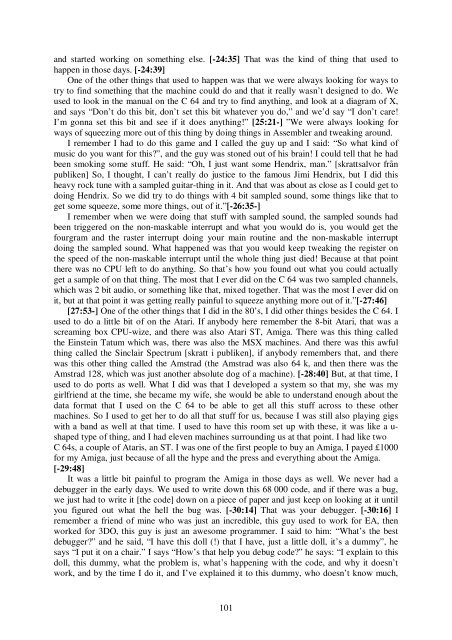Musikaliska uttryck och funktioner i interaktiva v rldar - C64.com
Musikaliska uttryck och funktioner i interaktiva v rldar - C64.com
Musikaliska uttryck och funktioner i interaktiva v rldar - C64.com
You also want an ePaper? Increase the reach of your titles
YUMPU automatically turns print PDFs into web optimized ePapers that Google loves.
and started working on something else. [-24:35] That was the kind of thing that used to<br />
happen in those days. [-24:39]<br />
One of the other things that used to happen was that we were always looking for ways to<br />
try to find something that the machine could do and that it really wasn’t designed to do. We<br />
used to look in the manual on the C 64 and try to find anything, and look at a diagram of X,<br />
and says “Don’t do this bit, don’t set this bit whatever you do,” and we’d say “I don’t care!<br />
I’m gonna set this bit and see if it does anything!” [25:21-] ”We were always looking for<br />
ways of squeezing more out of this thing by doing things in Assembler and tweaking around.<br />
I remember I had to do this game and I called the guy up and I said: “So what kind of<br />
music do you want for this?”, and the guy was stoned out of his brain! I could tell that he had<br />
been smoking some stuff. He said: “Oh, I just want some Hendrix, man.” [skrattsalvor från<br />
publiken] So, I thought, I can’t really do justice to the famous Jimi Hendrix, but I did this<br />
heavy rock tune with a sampled guitar-thing in it. And that was about as close as I could get to<br />
doing Hendrix. So we did try to do things with 4 bit sampled sound, some things like that to<br />
get some squeeze, some more things, out of it.”[-26:35-]<br />
I remember when we were doing that stuff with sampled sound, the sampled sounds had<br />
been triggered on the non-maskable interrupt and what you would do is, you would get the<br />
fourgram and the raster interrupt doing your main routine and the non-maskable interrupt<br />
doing the sampled sound. What happened was that you would keep tweaking the register on<br />
the speed of the non-maskable interrupt until the whole thing just died! Because at that point<br />
there was no CPU left to do anything. So that’s how you found out what you could actually<br />
get a sample of on that thing. The most that I ever did on the C 64 was two sampled channels,<br />
which was 2 bit audio, or something like that, mixed together. That was the most I ever did on<br />
it, but at that point it was getting really painful to squeeze anything more out of it.”[-27:46]<br />
[27:53-] One of the other things that I did in the 80’s, I did other things besides the C 64. I<br />
used to do a little bit of on the Atari. If anybody here remember the 8-bit Atari, that was a<br />
screaming box CPU-wize, and there was also Atari ST, Amiga. There was this thing called<br />
the Einstein Tatum which was, there was also the MSX machines. And there was this awful<br />
thing called the Sinclair Spectrum [skratt i publiken], if anybody remembers that, and there<br />
was this other thing called the Amstrad (the Amstrad was also 64 k, and then there was the<br />
Amstrad 128, which was just another absolute dog of a machine). [-28:40] But, at that time, I<br />
used to do ports as well. What I did was that I developed a system so that my, she was my<br />
girlfriend at the time, she became my wife, she would be able to understand enough about the<br />
data format that I used on the C 64 to be able to get all this stuff across to these other<br />
machines. So I used to get her to do all that stuff for us, because I was still also playing gigs<br />
with a band as well at that time. I used to have this room set up with these, it was like a ushaped<br />
type of thing, and I had eleven machines surrounding us at that point. I had like two<br />
C 64s, a couple of Ataris, an ST. I was one of the first people to buy an Amiga, I payed £1000<br />
for my Amiga, just because of all the hype and the press and everything about the Amiga.<br />
[-29:48]<br />
It was a little bit painful to program the Amiga in those days as well. We never had a<br />
debugger in the early days. We used to write down this 68 000 code, and if there was a bug,<br />
we just had to write it [the code] down on a piece of paper and just keep on looking at it until<br />
you figured out what the hell the bug was. [-30:14] That was your debugger. [-30:16] I<br />
remember a friend of mine who was just an incredible, this guy used to work for EA, then<br />
worked for 3DO, this guy is just an awesome programmer. I said to him: “What’s the best<br />
debugger?” and he said, “I have this doll (!) that I have, just a little doll, it’s a dummy”, he<br />
says “I put it on a chair.” I says “How’s that help you debug code?” he says: “I explain to this<br />
doll, this dummy, what the problem is, what’s happening with the code, and why it doesn’t<br />
work, and by the time I do it, and I’ve explained it to this dummy, who doesn’t know much,<br />
101


